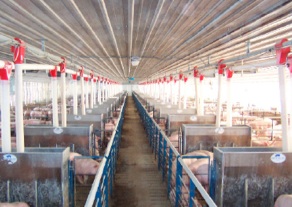
News
New diet is a breath of fresh air to animal facilities
January 28, 2009 by By Stacy Kish CSREES Staff
 January 28, 2009 – As populations expand into rural areas, more people
January 28, 2009 – As populations expand into rural areas, more people
are turning up their noses at malodorous livestock operations.
Fortunately, a multi-state team of researchers is working to introduce
a breath of fresh air into these important facilities and reduce the
environmental impact of animal waste.
January 28, 2009 – As populations expand into rural areas, more people are turning up their noses at malodorous livestock operations. Fortunately, a multi-state team of researchers is working to introduce a breath of fresh air into these important facilities and reduce the environmental impact of animal waste.
 |
| Pigs in commercial swine facilities used in the study. Photo by Gary Allee |
With funding from USDA’s Cooperative State Research, Education, and Extension Service (CSREES), Alan Sutton and colleagues at Purdue University, Michigan State University, and the University of Missouri developed and implemented diet modification strategies that reduce nutrient excretion and enhance air quality around pork operations.
In other words, they proved that what goes into the pig is important to what comes out.
The modified diets reduce nitrogen and phosphorus concentrations in manure, which, in turn, may better meet crop needs as fertilizer and limit the impact of these elements on the surrounding environment. The new diet also reduces odor levels surrounding swine facilities, which may lessen the concern from neighbors and increase the acceptance of the pork industry by surrounding communities.
The project team used crystalline amino acids to reduce crude protein in diets based on corn-soybean meal. This diet modification reduced nitrogen excretion by as much as 30 percent without negatively influencing growth, carcass value, or production costs. In addition, odor from the swine facility’s exhaust air decreased by 52 percent, ammonia emissions decreased by 61 percent, and hydrogen sulfide emissions decreased by 51 percent.
Pigs typically eat diets of corn-soybean meal. Two-thirds of the phosphorus in the diet is normally in the form of phytate, which is unnecessary for a pig’s growth. The unused phosphorus is excreted in the manure.
The project team used phytase (an enzyme that stimulates the release of phytate-bound phosphorus) or low-phytate corn to formulate diets based on available phosphorus content needed for growth and development. This approach reduced phosphorus excretion by up to 50 percent.
Removing the germ and hull during corn processing reduced the phytic phosphorus and fiber by 90 percent. This also reduced phosphorus excretion by as much as 40 percent. However, corn processed in this manner led to increased ulcers in pigs; this technology requires further modification to ensure animal health.
The economic impact of using these low nutrient excretion diets can be unpredictable due to changes in the cost of ingredients, especially synthetic amino acids and non-sulfur trace minerals, the availability of low phytate corn, and the availability of land for manure application.
“Modifying the pig’s diet to increase nutrient utilization and reduce excess nutrients decreases the potential impact of pork production on the environment, while having the added benefit of potentially reducing feed costs. It can be a win-win result,” Sutton said.
Many commercial operations that produce most of the pigs in the United States have already adapted many of these techniques. Nutritionists used mass balance equations to estimate nutrient excretion from different diets to provide the necessary information to producers, extension educators, consultants, and regulators so they, in turn, can develop efficient nutrient management plans.
For more information, visit http://www.csrees.usda.gov.